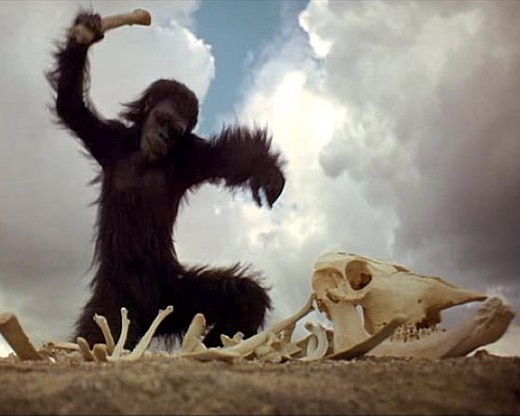From film blogger Justin Bozung’s interview with mime Dan Richter, a passage about how he came to be cast as “Moon-Watcher” in 2001: A Space Odyssey and how he prepared for the role:
“Justin Bozung:
So for those that haven’t read the book, could you tell me how you came to work on the film with Stanley Kubrick?
Dan Richter:
I had a friend at the time, a book publisher named Mike Wilson and he was working with Arthur C. Clarke on a series of books about diving. Arthur and Stanley had been discussing the ‘Dawn Of Man’ sequence because they had almost finished the live action shooting on 2001, but they still didn’t have an opening. They had tried a few different things but nothing seemed to worked right. They decided that maybe they should talk to a mime about some of their ideas. Arthur mentioned this to Mike Wilson, and because Mike and I had been friends, he said ‘I know a mime. His name is Dan Richter, and he’s great.’
So consequently, I was asked to go and meet with Stanley at Borehamwood Studios MGM outside of London. I figured he’d pick my brain, and I’d offer some suggestions. So I drove up to see him and we started to talk. Stanley started to explain to me some of the ideas they had had for the sequence that didn’t work. Thinking about it, I didn’t see his problems as having to do anything with acting, but rather as something to do with movement.
The ‘Dawn Of Man’ was for the opening of the film. The problem with the opening of a film or a play or a book is that you have to go and get your audience. You have a very short amount of time to get the audience involved, literally seconds of minutes. So it was important that we made the man-apes come to life.
Justin Bozung:
So you didn’t really go into the meeting thinking you were going in for a job interview with Kubrick?
Dan Richter:
I truthfully thought I was just going in to talk to him. I thought Stanley was just going to pick my brain, and I thought I’d just offer up suggestions to him in regards to how a mime could be of assistance to him in terms of solving his problems for the sequence. I didn’t know I was auditioning for him. I went in there acting cocky. I wasn’t worried about saying anything wrong to Stanley, because I wasn’t looking for a job. I was busy with other work in London at the time. I just thought I was there to give Stanley some pointers or whatever. I thought I was meeting with Stanley to explain mime movement to him.
Stanley and I hit it right off, and I think he liked my approach. After I was done talking Stanley asked me to show him what I was talking about. He wanted to see how to move as I had explained it to him. Then he offered me the job. So I told Stanley I’d have to do all of the choreography. I told him I’d help develop all of the man-apes costumes. The costumes initially were completely unworkable. You couldn’t move in them. Then I told Stanley that I’d cast and then train the people myself. I didn’t think he’d actually agree to my terms, but he said ‘yes’ to everything. So suddenly, I found myself with a immense job, and it was a job creating something that had never been done before. I was given an office, a rehearsal studio, assistants, and my name on a door and I was just this cocky kid. I had to deliver.
I mean, I had no ideas or plans to play ‘Moon-Watcher’ in the film. I thought I was there to just help with the research and the choreography of the actor’s movements. I never had any notions that Stanley would want me to play ‘Moon-Watcher’ in 2001.
Justin Bozung:
Then there was the enormous amount of research you did on apes.
Dan Richter:
I spent a great deal of time researching at the London Museum Of Natural History. I was granted access to their back stacks, and got to examine and study various skeletons and bones in their collection and all the early journals and research work the museum had acquired to that point.. I spent a lot of time talking to scientists with specialization in the Australopithecus era. Which of course, was the era that we were planning on setting the opening of the film in.
I also went to various zoo’s around England. With the zoo research I was studying the apes to develop a choreography. So I studied the apes at the zoo, so I could see how they interacted with each other in a tribe. How they moved, how their bodies reacted. So I began to study Gorillas, Chimpanzees, and Gibbons. Before my first trip Stanley had handed me a 8mm Bolex camera and told me to film everything. So I just went and filmed everything I observed. I was looking for the truth of it, I needed to know how they interacted with each other.
As we got closer to shooting, we were having a difficult time figuring out exactly how the man-apes should move. When I was at the zoo I filmed this Gibbon ape in slow motion coming down a tree and once he got down he began to just walk around. When I went back and watched the film I discovered this specific way in which the Gibbon walked. The Gibbon moves with their legs slightly bent with their knees pointing outward. Then, with the Chimps we decided it would be best to move our hands and arms in the same way that they moved theirs, which was at particular angle as well.”
Tags: Arthur C. Clarke, Dan Richter, Justin Bozung, Stanley Kubrick

